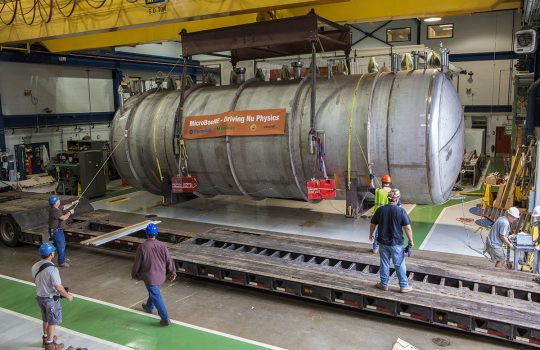Neutrinos are ubiquitous yet elusive particles that could shed light on the early evolution of the universe. As one of the world’s major laboratories for neutrino physics, Fermilab partners with leading organizations around the globe to get a firmer grasp on these subtle particles.
On Sept. 19, the University of Bern in Switzerland and the Department of Energy’s Fermilab signed an agreement to collaborate on neutrino experiments to be carried out at the laboratory. The agreement is the first such between Fermilab and a Swiss university. It covers the joint research and development of advanced neutrino detectors for three different experiments: MicroBooNE, SBND and the international Deep Underground Neutrino Experiment.
“I am proud of this agreement that witnesses the high quality of our basic research and our competitiveness to take part in collaborations at the highest international level,” said University of Bern Rector Christian Leumann.

On Sept. 19, the University of Bern in Switzerland and Fermilab signed an agreement to collaborate on neutrino experiments to be carried out at the laboratory. Seated, from left: Fermilab Director Nigel Lockyer, University of Bern Rector Christian Leumann, University of Bern scientist and group leader Antonio Ereditato. Standing, from left: Fermilab Chief of Staff Hema Ramamoorthi, Fermilab Office of Partnerships and Technology Transfer Manager Cherri Schmidt, Fermilab Neutrino Division Head Steve Brice, University of Bern Laboratory for High Energy Physics Deputy Director Michele Weber, Fermilab Deputy Director of Administration Tim Meyer, Department of Energy Federal LBNF/DUNE Project Director Pepin Carolan, Department of Energy Associate Director of Science for High Energy Physics Director Jim Siegrist. Photo: Reidar Hahn, Fermilab
DUNE will study neutrinos that are produced at Fermilab, outside Chicago, using its Long-Baseline Neutrino Facility and sent to Lead, South Dakota, 800 miles away. Neutrinos will be measured by a near detector hosted at Fermilab and by a far apparatus at Lead in an underground laboratory at the Sanford Underground Research Facility. This will allow scientists to study neutrino oscillations along the way. DUNE will also be able to detect neutrinos from astrophysical sources and will search for matter instability.
“This agreement brings to Fermilab a novel-design liquid-argon detector,” said Fermilab Director Nigel Lockyer. “What we learn will inform the final design of the DUNE near detector.”
Researchers at the University of Bern conceived, developed and prototyped a detector design, called ArgonCube, for the DUNE near-detector complex. The ArgonCube technology enables the fully spatial reconstruction of neutrino interactions with a novel configuration.
University of Bern researchers are also active in the Short-Baseline Neutrino program at Fermilab, which comprises three neutrino detectors to explore oscillations and search for a hypothesized but never observed particle called sterile neutrino. Bern scientists provided, for the two Short-Baseline Neutrino detectors MicroBooNE and SBND, the UV-laser calibration system and the cosmic-ray tagger detector. The latter in particular allows the identification of particles of cosmic origin. These constitute a serious source of background for neutrino experiments but can be efficiently detected and removed by the cosmic-ray tagger.
“This international agreement is a paradigmatic example representative of the global approach required to meet the challenges of modern neutrino physics projects,” said Bern group leader Antonio Ereditato.
Fermilab’s research is supported by the DOE Office of Science.



